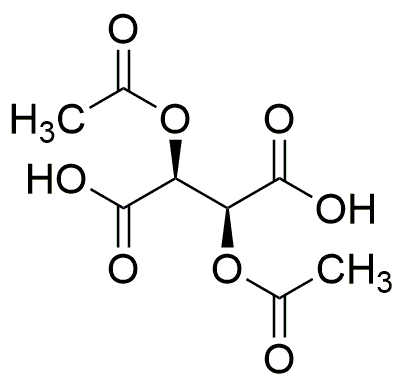(+)-Diacetyl-D-tartaric acid is widely utilized in research focused on
- Food Industry: This compound serves as a chiral building block in the synthesis of flavoring agents and food additives, enhancing the taste and aroma of various products.
- Pharmaceuticals: It is used in the development of drugs, particularly in creating chiral intermediates that improve the efficacy and safety profiles of medications.
- Cosmetics: The compound acts as a stabilizer and emulsifier in cosmetic formulations, ensuring product consistency and enhancing skin feel.
- Biotechnology: It plays a role in the production of biocatalysts, aiding in the development of environmentally friendly processes for synthesizing complex organic molecules.
- Research Applications: As a reagent in asymmetric synthesis, it allows chemists to create compounds with specific stereochemistry, which is crucial in various scientific studies.
General Information
Properties
Safety and Regulations
Applications
(+)-Diacetyl-D-tartaric acid is widely utilized in research focused on
- Food Industry: This compound serves as a chiral building block in the synthesis of flavoring agents and food additives, enhancing the taste and aroma of various products.
- Pharmaceuticals: It is used in the development of drugs, particularly in creating chiral intermediates that improve the efficacy and safety profiles of medications.
- Cosmetics: The compound acts as a stabilizer and emulsifier in cosmetic formulations, ensuring product consistency and enhancing skin feel.
- Biotechnology: It plays a role in the production of biocatalysts, aiding in the development of environmentally friendly processes for synthesizing complex organic molecules.
- Research Applications: As a reagent in asymmetric synthesis, it allows chemists to create compounds with specific stereochemistry, which is crucial in various scientific studies.
Documents
Safety Data Sheets (SDS)
The SDS provides comprehensive safety information on handling, storage, and disposal of the product.
Product Specification (PS)
The PS provides a comprehensive breakdown of the product’s properties, including chemical composition, physical state, purity, and storage requirements. It also details acceptable quality ranges and the product's intended applications.
Certificates of Analysis (COA)
Search for Certificates of Analysis (COA) by entering the products Lot Number. Lot and Batch Numbers can be found on a product’s label following the words ‘Lot’ or ‘Batch’.
*Catalog Number
*Lot Number
Certificates Of Origin (COO)
This COO confirms the country where the product was manufactured, and also details the materials and components used in it and whether it is derived from natural, synthetic, or other specific sources. This certificate may be required for customs, trade, and regulatory compliance.
*Catalog Number
*Lot Number
Safety Data Sheets (SDS)
The SDS provides comprehensive safety information on handling, storage, and disposal of the product.
DownloadProduct Specification (PS)
The PS provides a comprehensive breakdown of the product’s properties, including chemical composition, physical state, purity, and storage requirements. It also details acceptable quality ranges and the product's intended applications.
DownloadCertificates of Analysis (COA)
Search for Certificates of Analysis (COA) by entering the products Lot Number. Lot and Batch Numbers can be found on a product’s label following the words ‘Lot’ or ‘Batch’.
*Catalog Number
*Lot Number
Certificates Of Origin (COO)
This COO confirms the country where the product was manufactured, and also details the materials and components used in it and whether it is derived from natural, synthetic, or other specific sources. This certificate may be required for customs, trade, and regulatory compliance.


